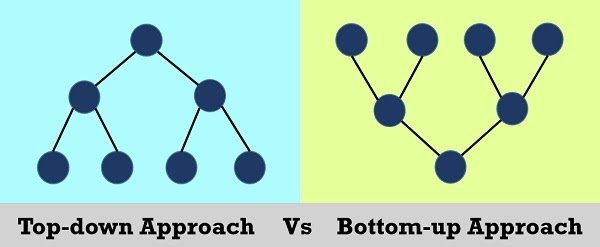

When talking in terms of computer science and programming, the algorithms we use to solve complex problems in a systematic and controlled way are designed on the basis of two approaches that is Top-down and Bottom-up approach. The ideology behind top-down approach is, a bigger problem is divided into some smaller sub-problems called modules, these modules are then solved individually and then integrated together to get the complete solution to the problem. In bottom-up approach on the other hand, the process starts with elementary modules and then combining together to get the desired result.
Top-Down vs. Bottom-Up: An Overview
Top-down and bottom-up approaches are methods used to analyze and choose securities. However, the terms also appear in many other areas of business, finance, investing, and economics. While the two schemes are common terms, many investors get them confused or don’t fully understand the different approaches at all.
Generally, each can be quite simple. The top-down approach goes from the general to the specific, and the bottom-up approach begins at the specific and moves to the general.
Comprehensively these methods can be possible approaches for a wide range of endeavors such as goal setting, budgeting, and forecasting. However, in the financial world, analysts or whole regimes may be tasked with focusing on one over the other so understanding the nuances of both is important.
KEY TAKEAWAYS
- Top-down usually encompasses a vast universe of macro variables while bottom-up is more narrowly focused.
- Top-down investing strategies typically focus on exploiting opportunities that follow market cycles while bottom-up approaches are more fundamental in nature.
- While top-down and bottom-up can be very distinctly different they are often each used in all types of financial approaches like checks and balances.
Top-Down
Top-down analysis generally refers to using comprehensive factors as a basis for decision making. The top-down approach will seek to identify the big picture and all of its components. These components will usually be the driving force for the end goal.
Overall, top-down is commonly associated with the word macro or macroeconomics. Macroeconomics itself is an area of economics that looks at the biggest factors affecting the economy as a whole. These factors often include things like the federal funds rate, unemployment rates, global and country-specific gross domestic product, and inflation rates.
An analyst seeking a top-down perspective will want to look at how systematic factors are affecting an outcome. In corporate finance, this can mean understanding how big picture trends are affecting the entire industry. In budgeting, goal setting, and forecasting the same concept can also apply to understand and manage the macro factors.
In top down model, an overview of system is formulated without going into details for any part of it. Each part of it then refined into more details, defining it in yet more details until the entire specification is detailed enough to validate the model. if we glance at a haul as a full, it’s going to appear not possible as a result of it’s so complicated For example: Writing a University system program, writing a word processor. Complicated issues may be resolved victimization high down style, conjointly referred to as Stepwise refinement where,
- We break the problem into parts,
- Then break the parts into parts soon and now each of part will be easy to do.
Advantages:
- Breaking problems into parts help us to identify what needs to be done.
- At each step of refinement new parts will become less complex and therefore easier to solve.
- Parts of solution may turn out to be reusable.
- Breaking problems into parts allows more than one person to solve the problem.
Bottom-Up
The bottom-up analysis takes a completely different approach. Generally, the bottom-up approach will focus its analysis on specific characteristics and micro attributes of an individual stock. In bottom-up investing concentration is on business-by-business or sector-by-sector fundamentals. This analysis seeks to identify profitable opportunities through the idiosyncrasies of a company’s attributes and its valuations in comparison to the market.
Bottom-up investing begins its research at the company level but does not stop there. These analyses weigh company fundamentals heavily but also look at the sector, and microeconomic factors as well. As such, bottom-up investing can be somewhat broad across an entire industry or laser-focused on identifying key attributes.
In this design, individual parts of the system are specified in details. The parts are the linked to form larger components, which are in turn linked until a complete system is formed. Object oriented language such as C++ or java uses bottom up approach where each object is identified first.
Advantage:
- Make decisions about reusable low level utilities then decide how there will be put together to create high level construct.
- Contrast between Top down design and bottom up design.
What Are The Key Differences Between The Top-Down And The Bottom-Up Approaches?
Based on the core preferences and values of each methodology, we can chalk out certain basic differences between the two. They are:
- While the top-down approach focuses on breaking down a big problem into smaller and understandable chunks, the bottom-up approach first focuses on solving the smaller problems at the fundamental level and then integrating them into a whole and complete solution.
- The top-down approach is primarily used by structured programming languages such as C, COBOL, Fortran. On the contrary, the bottom-up approach is preferred by OOP languages such as C++, C#, Python, Java, and Perl.
- In the top-down approach, each module and submodule are processed separately, and hence, they might contain redundant information. However, the bottom-up approach relies on data encapsulation and data-hiding, thereby, minimizing redundancy.
- The top-down approach doesn’t require the modules to have a well-established line of communication among them, whereas, in the bottom-up approach, the modules must have a certain degree of interaction and communication among them.
- While the top-down approach can be used in module documentation, debugging, and code implementation, the bottom-up approach is primarily used in testing.
| S.NO. | TOP DOWN APPROACH | BOTTOM UP APPROACH |
|---|---|---|
| 1. | In this approach We focus on breaking up the problem into smaller parts. | In bottom up approach, we solve smaller problems and integrate it as whole and complete the solution. |
| 2. | Mainly used by structured programming language such as COBOL, Fortan, C etc. | Mainly used by object oriented programming language such as C++, C#, Python. |
| 3. | Each part is programmed separately therefore contain redundancy. | Redundancy is minimized by using data encapsulation and data hiding. |
| 4. | In this the communications is less among modules. | In this module must have communication. |
| 5. | It is used in debugging, module documentation, etc. | It is basically used in testing. |
| 6. | In top down approach, decomposition takes place. | In bottom up approach composition takes place. |
| 7. | In this top function of system might be hard to identify. | In this sometimes we can not build a program from the piece we have started. |
| 8. | In this implementation details may differ. | This is not natural for people to assemble. |




